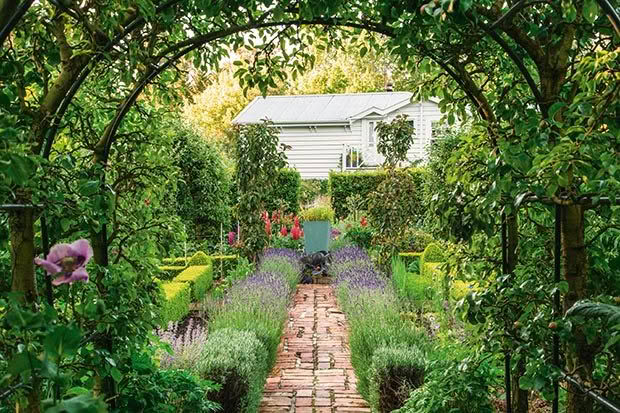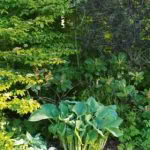What Carolyn Ferraby learned creating Barewood Garden in Marlborough

Every vista in this world-class garden, photographed through the seasons, tempts visitors down a path laden with promise. Barewood Garden’s creator shares how she’s grown alongside her garden.
Words: Kate Coughlan Photos: Jane Ussher
Every night, as Carolyn Ferraby falls asleep, she imagines the area of her garden in which she’s been working that day. In her sleepy mind’s eye, she visualizes how she wants it to look in a year’s time and the work needed to get it there.
Should that plan require husband Joe to take out a fence, she might pause for further thought. For in this tranquil place, where tall trees stand at a respectful distance, keeping out the wind and the world’s woes, there has been the odd mutinous mutter of murder.
“I’ve told Carolyn that she’ll be going into the first posthole of the next fence I have to take out,” says Joe.

The famed hawthorn walk at Barewood is gardener Carolyn Ferraby’s pride and joy. I Mowing the Barewood lawns is a task for only the very talented, especially in areas of different length grass. “One of the few clever things I’ve done in my life is to never learn how to mow in straight lines,” says Carolyn. “That’s Joe’s domain. Mowing, making the coffee… And oh, the mess I can make with a paintbrush in my hand. Joe gets the shakes if he even thinks of me painting a room.”
Over the course of Joe and Carolyn’s 47-year marriage, Joe has walked fences backwards so many times, the garden now envelopes 1.7 hectares of this second-generation Ferraby farm, 20 kilometres inland from Seddon. On one occasion he dispensed with a fence entirely.
Famed English landscaper Capability Brown’s love of a clear pastoral outlook and subsequent development of the ha-ha, means the lack of a fence does not allow 1000-odd sheep, often awaiting shearing nearby, to graze in this earthly paradise.

In spring, the hawthorn walk’s flower-laden bowers draw visitors past the pond to sit in the peaceful summerhouse overlooking the punt Carolyn’s husband Joe built.
The greatest beneficiaries of Carolyn’s lifetime of creating the garden are Carolyn herself and husband Joe, and their Wellington-based daughter Meredith, her husband Michael Dreyer, and three granddaughters Matilda, Alex and Harriet.
Also lucky to share the enjoyment of Barewood are the 1000-odd tourists who come every year, many by the busload from cruise ships berthed in Picton, and others who tootle themselves along the dusty road drawn by the garden’s now famed status.

The apple arbor.
These visitors wonder at the dreamy vistas and wander the leafy lanes of the misleadingly named Barewood.
For this garden, a 40-minute drive into the hills south of Blenheim, and assessed by the New Zealand Gardens Trust as being of International Significance (therefore a six-star visitor destination), is anything but bare of wood.
Watch Carolyn Ferraby of Barewood Garden in Marlborough talk about how she developed the apple arbor
“You create a garden for yourself and when I started I certainly had no idea this would happen, that we’d have so many people come to the garden. That was never in any plan, in fact there never was any plan. My mother-in-law thought I might be lonely at Barewood and suggested I’d better start a garden.”

Having a pair of summerhouses was not part of Carolyn’s overall grand plan originally. The first summerhouse was built before the pond was dug and, once in, Carolyn lamented that she could not see it from the summerhouse. A visitor advised her to whip the back out of the existing summerhouse and build another one behind. So she did – actually Joe did. Her second summerhouse overlooks the pond perfectly and the original summerhouse has become a special entrance to the new one.
During her mother-in-law’s time, there was an efficient kitchen garden, a few fruit trees and flower borders so Barewood was a blank canvas for the young florist from Tuamarina who says she fell in love with Joe first but also quickly fell in love with the Barewood homestead.
“I loved it from the first moment I saw it, and still do. Loving the house has been instrumental in how I’ve developed the garden. I believe in Gertrude Jekyll’s advice that the garden should curtsey to the house.”
Carolyn’s first step was to reroute the drive away from butting against the house, which cut the garden in two. She next dismantled an ugly sunroom and returned a wide wraparound verandah to the north-west corner of the house.
- She loves the deep verandahs that run on two sides of her home and provide outdoor living almost all year around.
- The Malus tschonoskii were planted 15 years ago and touch overhead. Walking the allée beneath these elegant trees is a little like walking through the cloisters of an ancient cathedral.
- The dripping Wisteria floribunda “alba” is complemented by shrubs and plants in soft colours.
- “If plants come out in the wrong colour, we pull them out, throw them on the lawn and Joe mows them up,” says Carolyn.
- Illustrating the pursuit of the perfect picture of colour-on-colour with differing form.
- Under the old gum sits an old horse-drawn mower that was used at Barewood and is a reminder to garden visitors that this is still a working farm.
- Illustrating the pursuit of the perfect picture of colour-on-colour with differing form.
- Softer colour in the garden.
Then she turned her attention to Barewood’s clay soils. Her early reliance on Joe’s method of breaking in clay came to an abrupt end when he gelignited an area for a new garden bed with an explosion so huge a nearby horse cover flew irretrievably high into a tree.
In those days, all hill country farmers on clay soil had sheds full of gelignite to blast their farm tracks.

Carolyn, who trained as a florist, sees her garden as a series of flower arrangements and looks for the elements of form.
Carolyn replaced the explosive method with a sweat-of-the-brow one; the application of massive amounts of sawdust, sheep manure, compost, lime and gypsum. And that has gone on, and on, throughout the decades since to break down the clay, release the nutrients and create soil.
If Joe’s ability to blow up things didn’t impress, his ability to put up things did.

She loves the deep verandahs that run on two sides of her home and provide outdoor living almost all year around.
While she is the undoubted architect of the garden as well as its plantswoman, seeder, digger, planner, planter, shrub-shifter and feeder, Joe builds the structures she says are integral to its overall success.

Carolyn and her friend Ngaire Simonsen, who has helped her at Barewood for many years, are brutal in their pursuit of the perfect picture of colour-on-colour with differing form.
“This garden would not be what it is without Joe’s structures. He can build anything. And he doesn’t procrastinate – far from it.”
And when Carolyn gets an idea in her head about something she wants built, rest assured it is not going to be a pre-fab garden shed. Case in point: the twin arbors joined by a 20-metre pergola alongside the rose garden lawn were inspired by Anne Boleyn’s childhood home, Hever Castle in Kent.

The theme of colour-on-colour is illustrated by the wisteria arch with its blue racemes, accompanied by the clematis flowers in their bell shapes and the underplanting of Symphytum caucasium.
The magnificent beauty of the castle’s famous lakeside Palladian walkway certainly turns most visitors’ heads. But in the case of this particular garden-mad farmer’s wife from the hills south of Blenheim, the head went on its side, the eyes squinted and the brain whirred.
She saw the flowing elegance of the 700-year-old yellow stone pergola walk and loggia for sure, but she also saw, in that fertile mind’s eye so important to an avid gardener, a dry clay bank on a bare Marlborough hillside. The more she peered, the more she saw.

The potager uses French principles of vegetable gardening with separate areas bordered by bee-friendly flowering plants, such a lavender, and brick paths between.
“I defy anyone to look at my arbors and pergola and recognize Hever Castle in them, but that’s the value in seeing great gardens. They inspire you to see your own in a different light and do things you’d never have dreamed of on your own.”
The Hever pergola project – perilously – inspired more than gardening. It also prompted more murderous mutterings. This time from Carolyn’s brother.
- Rosa Complicata
- Rosa Cornelia
- Rosa William Shakespere 2000
- Iris Siberica Hapswell Happiness
- Rosa Desprez a Fleur Jaune
- Rosa Chaucer
“He was helping Joe hold up four-by-two planks while I tried to work out the right roof pitch. He said to Joe, ‘Why don’t we just take these four-by-twos and beat her to death with them? Save us a lot of bother.’”
Carolyn, calm as a gentle breeze ruffling her hawthorn walk, recounts this plotting of her death without concern.
“That’s the difference between a brother and a husband,” she says, not quite illuminating the situation.
- Autumn paints the garden with one of its strongest palettes.
- The entrancing arrival at Barewood, where many cruise-ship visitors enjoy hours of dreamy garden wandering and often wide-eyed farming experiences such as paddocks full of ewes awaiting shearing.
- The malus allée glisters with a burnished gold, and the dahlia rocks a deep burnt orange complementing the autumn hues.
- The pavilion is framed by ornamental grape Vitis amurensis, another great performer in terms of autumn colour.
- Great autumn colour.
- The 80-year-old cox’s orange apple is a strong performer going into winter.
- The bushes stand sentinel in the corner of each buxus rectangle, holding back the bursts of colourful clematis, geraniums and roses.
- Lighting the summerhouse with candles and tea lights is a Barewood tradition that Carolyn and her granddaughters enjoy together.
Very little deters her once she gets an idea in her head, be it a punt or a pergola, a sculptural throne seat or a water jet spouting vertically from the ground beneath a stand of lombardy poplars.
While Joe might speculate on her master’s degree in nagging, the enthusiasm with which he tackles each new project, and the fine results, indicates he is more than a willing participant. Even when called upon to “unbuild”. Take the summerhouse, for example: built and then unbuilt.

Carolyn and Jo Ferraby of Barewood Homestead.
“You make mistakes,” she says, unfazed, “and things have to evolve.”
The vista from the summerhouse, in which the family often gathered for candle-lit evenings, took in the magnificent hawthorn walk but was completed prior to the excavation of a nearby pond under an old willow. Carolyn regretted that the lovely pond (adorned with a Joe-built punt) was not easily seen from the summerhouse.

There’s always work for willing granddaughters who enjoy a good autumn leaf burn-up.
Enter Australian gardening expert Michael McCoy who, upon hearing Carolyn lamenting the lack of a pond vista, told her to cut a hole in the back of the summerhouse and build another one behind it.
Go Joe, that’s two summerhouses under his belt now. The shell of summerhouse one has become an example of what Carolyn believes is crucial in a serene garden – a transition space or structure leading from one part of the garden to another.

Barewood is much-loved by Joe and Carolyn’s three grandaughters (Matilda, 9, Harriet, 5, and Alexandra, 7) who visit regularly from Wellington.
“In order to create a calm experience, it is important to transition from one area (or room in the garden) to another and this is often done by a simple green area, or grass mown at a different height, or routine shapes which take the eye in a specific direction. The hawthorn walk, for example, leads from the busy colours of the rose garden down to the more secluded pond and orchard area, and does so along a symmetrical and structured planting, all in calm colours.

Carolyn collecting some of the fruit from her labour.
“People always say the garden is so serene, but they can’t put their finger on why. I believe this is the reason.”
Despite Carolyn’s nightly ruminations about what will happen next in the Barewood gardens (and there’s plenty yet to come) she’s learned never to presume she is the queen of it all.
Nature will do its thing as it chooses.

Soft peachy tones are reflected in the summer flowering border garden which fronts the brick wall.
“The garden teaches you, and you grow with it. You might be thinking you are going to achieve something, and the excitement of the promise is there. But nature might show you something quite different.
“People sometimes compare creating a garden to painting a picture but to me gardening is all the more exciting because once you’ve put paint on a canvas, it is there, it is done. But with gardening, it’s all in the promise… that’s the excitement that’s never waned for me. That and the fact that I’m still learning after 40 years.”
BAREWOOD HISTORY

The pavilion, inspired by Anne Boleyn’s childhood home of Hever Castle.
Barewood was cut from the neighbouring large station of Richmond Brook in the late 1890s.
Joe’s parents purchased the property after his father had moved south, from a farming cadetship with A.B. Williams on the large East Cape station of Puketiti, to marry.
Joe’s father was a World War I orphan. He came to New Zealand as a young man on the advice of his headmaster who advised him to go to Rhodesia, Australia or New Zealand.
He met Joe’s mother on a ship when returning to Britain. The ship-board romance brought the young couple back to her home town of Blenheim where there was a beef and sheep farm for sale.
When Joe took over the 600-hectare farm in 1969, 75 per cent of the revenue was from wool. Now wool provides 10 per cent, with most of the rest from export lamb production.
GREAT GARDENS OF MARLBOROUGH

The theme of colour-on-colour is illustrated by the wisteria arch with its blue racemes.
Carolyn’s belief in the value of visiting great gardens saw her, along with two other local gardeners, Puddy Shields of Bankhouse and Richard Macfarlane of Winterhome, establish the now nationally famous Garden Marlborough.
The event draws 3000 visitors to the region every spring for a four-day festival of gardens and gardening.
“Richard and Puddy and I worked with our local tourism manager, Maryanne Webber, who said we needed to create an event highlighting gardens in Marlborough.”

There’s a joyous fecundity within these orderly buxus hedges and it feeds the extended Barewood family almost all year round.
Twenty-four years later, this celebration of gardens is a drawcard for visitors from throughout New Zealand and overseas, and always features a famous international speaker.
Carolyn is thrilled to have one of her favourite gardening greats coming this year: Fergus Garrett, from leading UK garden Great Dixter, is known for his brave and exciting use of plants and ability to evolve a mature garden in dynamic new ways.
Fergus will deliver two keynote events, and tickets to these tend to sell out rapidly.
Carolyn has always been an avid garden tourist.
She, and her late, very dear friend Yvonne Richmond, visited Sissinghurst as young gardeners. Carolyn was so overwhelmed to be actually visiting the famous garden, she burst into tears at the gates.
Once inside, she and Yvonne couldn’t tear themselves away and on three occasions having left the grounds looked at each other and asked, ‘Shall we just go back in once more?’ “Each time we went back in, we saw something different.” In all, Carolyn has visited Sissinghurst five times.
See Carolyn’s garden as part of Garden Marlborough, Rapaura Springs Bloom in the Boom 5-8 November.
Love this story? Subscribe now!
 This article first appeared in NZ Life & Leisure Magazine.
This article first appeared in NZ Life & Leisure Magazine.






















